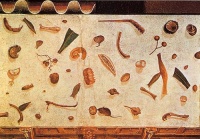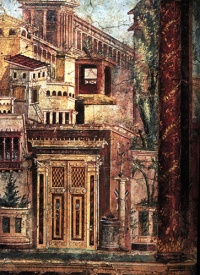Roman art
From The Art and Popular Culture Encyclopedia

|
Related e |
|
Featured: |
Roman art refers to the visual arts produced in Ancient Rome, and in the territories of the Roman empire. Major forms of Roman art are architecture, painting, sculpture and mosaic work. Metal-work, coin-die and gem engraving, ivory carvings, figurine glass, pottery, and book illustrations are considered to be 'minor' forms of Roman artwork.
Contents |
Painting
Our knowledge of Ancient Roman painting relies in large part on the preservation of artifacts from Pompeii and Herculaneum, and particularly the Pompeian mural painting, which was preserved after the eruption of Vesuvius in 79 AD. Nothing remains of the Greek paintings imported to Rome during the 4th and 5th centuries, or of the painting on wood done in Italy during that period. In sum, the range of samples is confined to only about 200 years out of the about 900 years of Roman history, and of provincial and decorative painting. Most of this wall painting was done using the secco (“dry”) method, but some fresco paintings also existed in Roman times. There is evidence from mosaics and a few inscriptions that some Roman paintings were adaptations or copies of earlier Greek works. However, adding to the confusion is the fact that inscriptions may be recording the names of immigrant Greek artists from Roman times, not from Ancient Greek originals that were copied.
Another source of Roman painting are the painted rooms of the Domus Aurea.
Variety of subjects
Roman painting provides a wide variety of themes: animals, still life, scenes from everyday life, portraits, and some mythological subjects. During the Hellenistic period, it evoked the pleasures of the countryside and represented scenes of shepherds, herds, rustic temples, rural mountainous landscapes and country houses. Erotic scenes are also relatively common. In the late empire, after 200AD, early Christian themes mixed with pagan imagery survive on catacomb walls.
Periods
Roman mural painting is generally distinguished by four periods, as originally described by the German archaeologist August Mau and dealt with in more detail at Pompeian Styles.
Landscape and vistas
The main innovation of Roman painting compared to Greek art was the development of landscapes, in particular incorporating techniques of perspective, though true mathematical perspective developed 1,515 years later. Surface textures, shading, and coloration are well applied but scale and spatial depth was still not rendered accurately. Some landscapes were pure scenes of nature, particularly gardens with flowers and trees, while others were architectural vistas depicting urban buildings. Other landscapes show episodes from mythology, the most famous demonstrating scenes from the Odyssey.
The art of the ancient East would have known the landscape only in terms of civil or military scenes. This theory, defended by Franz Wickhoff, is debatable. It is possible to see evidence of Greek knowledge of landscape portrayal in Plato's Critias (107b–108b):... and if we look at the portraiture of divine and of human bodies as executed by painters, in respect of the ease or difficulty with which they succeed in imitating their subjects in the opinion of onlookers, we shall notice in the first place that as regards the earth and mountains and rivers and woods and the whole of heaven, with the things that exist and move therein, we are content if a man is able to represent them with even a small degree of likeness ...
Still life
Roman still life subjects are often placed in illusionistic niches or shelves and depict a variety of everyday objects including fruit, live and dead animals, seafood, and shells. Examples of the theme of the glass jar filled with water were skillfully painted and later served as models for the same subject often painted during the Renaissance and Baroque periods.
Portraits
Pliny complained of the declining state of Roman portrait art, "The painting of portraits which used to transmit through the ages the accurate likenesses of people, has entirely gone out ... Indolence has destroyed the arts."
In Greece and Rome, wall painting was not considered as high art. The most prestigious form of art besides sculpture was panel painting, i.e. tempera or encaustic painting on wooden panels. Unfortunately, since wood is a perishable material, only a very few examples of such paintings have survived, namely the Severan Tondo from circa 200 AD, a very routine official portrait from some provincial government office, and the well-known Fayum mummy portraits, all from Roman Egypt, and almost certainly not of the highest contemporary quality. The portraits were attached to burial mummies at the face, from which almost all have now been detached. They usually depict a single person, showing the head, or head and upper chest, viewed frontally. The background is always monochrome, sometimes with decorative elements. In terms of artistic tradition, the images clearly derive more from Greco-Roman traditions than Egyptian ones. They are remarkably realistic, though variable in artistic quality, and may indicate the similar art which was widespread elsewhere but did not survive. A few portraits painted on glass and medals from the later empire have survived, as have coin portraits, some of which are considered very realistic as well.
Genre scenes
Roman genre scenes generally depict Romans at leisure and include gambling, music and sexual encounters. Some scenes depict gods and goddesses at leisure.
Triumphal paintings
From the 3rd century BC, a specific genre known as Triumphal Paintings appeared, as indicated by Pliny (XXXV, 22). These were paintings which showed triumphal entries after military victories, represented episodes from the war, and conquered regions and cities. Summary maps were drawn to highlight key points of the campaign. Josephus describes the painting executed on the occasion of Vespasian and Titus's sack of Jerusalem:
There was also wrought gold and ivory fastened about them all; and many resemblances of the war, and those in several ways, and variety of contrivances, affording a most lively portraiture of itself. For there was to be seen a happy country laid waste, and entire squadrons of enemies slain; while some of them ran away, and some were carried into captivity; with walls of great altitude and magnitude overthrown and ruined by machines; with the strongest fortifications taken, and the walls of most populous cities upon the tops of hills seized on, and an army pouring itself within the walls; as also every place full of slaughter, and supplications of the enemies, when they were no longer able to lift up their hands in way of opposition. Fire also sent upon temples was here represented, and houses overthrown, and falling upon their owners: rivers also, after they came out of a large and melancholy desert, ran down, not into a land cultivated, nor as drink for men, or for cattle, but through a land still on fire upon every side; for the Jews related that such a thing they had undergone during this war. Now the workmanship of these representations was so magnificent and lively in the construction of the things, that it exhibited what had been done to such as did not see it, as if they had been there really present. On the top of every one of these pageants was placed the commander of the city that was taken, and the manner wherein he was taken.
These paintings have disappeared, but they likely influenced the composition of the historical reliefs carved on military sarcophagi, the Arch of Titus, and Trajan's Column. This evidence underscores the significance of landscape painting, which sometimes tended towards being perspective plans.
Ranuccio also describes the oldest painting to be found in Rome, in a tomb on the Esquiline Hill:
- It describes a historical scene, on a clear background, painted in four superimposed sections. Several people are identified, such Marcus Fannius and Marcus Fabius. These are larger than the other figures ... In the second zone, to the left, is a city encircled with crenellated walls, in front of which is a large warrior equipped with an oval buckler and a feathered helmet; near him is a man in a short tunic, armed with a spear...Around these two are smaller soldiers in short tunics, armed with spears...In the lower zone a battle is taking place, where a warrior with oval buckler and a feathered helmet is shown larger than the others, whose weapons allow to assume that these are probably Samnites.
This episode is difficult to pinpoint. One of Ranuccio's hypotheses is that it refers to a victory of the consul Fabius Maximus Rullianus during the second war against Samnites in 326 BC. The presentation of the figures with sizes proportional to their importance is typically Roman, and finds itself in plebeian reliefs. This painting is in the infancy of triumphal painting, and would have been accomplished by the beginning of the 3rd century BC to decorate the tomb.
See also
- Latin literature
- Music of ancient Rome
- Naturalis Historia
- Pliny the Elder
- Roman architecture
- Roman sculpture
- Erotic art in Pompeii and Herculaneum
Examples


